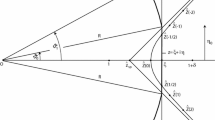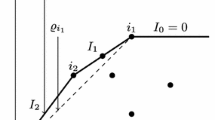Abstract
This paper presents the exact asymptotics of the steady state behavior of a broad class of single-node queueing systems. First we show that the asymptotic probability functions derived using large deviations theory are consistent (in a certain sense) with the result using dominant pole approximations. Then we present an exact asymptotic formula for the cumulative probability function of the queue occupancy and relate it to the “cell loss ratio”, an important performance measure for service systems such as ATM networks. The analysis relies on a new generalization of the Taylor coefficients of a complex function which we call “characteristic coefficients”. Finally we apply our framework to obtain new results for the M/D/1 system and for a more intricate multiclass M/D/n system.
Similar content being viewed by others
References
M. Abramowitz and I.A. Stegun,Handbook of Mathematical Functions (Dover, New York, 1968).
Arnold O. Allen,Probability, Statistics, and Queueing Theory, Computer Science and Applied Mathematics (Academic Press, Orlando, 1978).
P. Billingsley,Probability and Measure (Wiley, New York, 1986).
C. Bisdikian, J.S. Lew and A.N. Tantawi, On the tail approximation of the blocking probability of single server queues with finite buffer capacity, in:Queueing Networks with Finite Capacity, Proc. 2nd Int. Conf. (May 28–29, 1992) pp. 267–280.
H. Bruneel and B.G. Kim,Discrete-Time Models for Communication System Including ATM (Kluwer Academic Publishers, Boston, 1993).
B. Steyaert and H. Bruneel, Analytic derivation of the cell loss probability in finite multiserver buffers, from infinite buffer results,Proceedings of the Second Workshop on Performance Modelling and Evaluation of ATM Networks, Bradford, UK (June, 1994) 18.1–11.
H.E. Daniels, Saddlepoint approximations in statistics,The Annals of Mathematical Statistics 25 (1954) 631–650.
A. Dembo and O. Zeitouni,Large Deviations Techniques and Appications (Jones & Bartlett, Boston, 1992).
A. Elwalid, D. Heyman, T.V. Lakshman, D. Mitra and A. Weiss, Fundamental bounds and approximations for ATM multiplexers with applications to video teleconferencing,IEEE Journal on Selected Areas in Communications 13(6) (August, 1995) 1004–1016.
R.J. Gibbens and P.J. Hunt, Effective bandwidths for the multi-type UAS channel,Queueing Systems 9 (1991) 17–28.
R. Guerin, H. Ahmadi and M. Naghshineh, Equivalent capacity and its application to bandwidth allocation in high-speed networks,IEEE Journal on Selected Areas in Communications 9(7) (September, 1991) 968–981.
G.H. Hardy,Divergent Series (Oxford Univ. Press, London, 1948).
J.Y. Hui, Resource allocation for broadband networks,IEEE Journal on Selected Areas in Communications 6(9) (December, 1988) 1598–1608.
ITU-T, Traffic control and congestion control in B-ISDN,Recommendation I.371 (November, 1995).
F.P. Kelly, Effective bandwidths at multi-class queues,Queueing Systems 9 (1991) 5–16.
G. Kesidis, J. Walrand and C.-S. Chang, Effective bandwidths for multiclass markov fluids and other ATM sources,IEEE/ACM Trans. Networking 1(4) (August, 1993) 424–428.
L. Kleinrock,Queueing Systems, Volume 1:Theory (Wiley, New York, 1975).
Arthur Y-M. Lin and John A. Silvester, Priority queueing strategies and buffer allocation protocols for traffic control at an ATM integrated broadband switching system,IEEE Journal on Selected Areas in Communications 9(9) (1991) 1524–1536.
A.I. Markushevich,Theory of Functions of a Complex Variable, Vols I–III (Chelsea, New York, 1985).
P. Van Mieghem, The characteristic coefficients of a complex function (unpublished, 1995).
P. Van Mieghem, J. David and G.H. Petit, Performance of cell loss priority management schemes in shared buffers with poisson arrivals,IEEE Journal on Selected Areas in Communications (submitted, 1996).
W.H. Press, S.A. Teukolsky, W.T. Vetterling and B.P. Flannery,Numerical Recipes in C (Cambridge Univ. Press, New York, second edition, 1992).
J.W. Roberts,Performance Evaluation and Design of Multiservice Networks, Volume COST 224 ofInformation Technologies and Sciences (Commission of the European Communities, Luxembourg, October, 1991).
K. Sohraby, On the theory of general on-off sources with applications in high-speed networks,IEEE Infocom (1993) (4a.3) 1–10.
R. Syski,Introduction to Congestion Theory in Telephone Systems, Studies in Telecommunication, Vol. 4 (North-Holland, Amsterdam, second edition, 1986).
E.C. Titchmarsh,The Theory of Functions (Oxford Univ. Press, Amen House, London EC4, 1964).
A. Weiss, An introduction to large deviations for communication networks,IEEE Journal on Selected Areas in Communications 13(6) (1995) 938–952.
R.W. Wolff, Poisson arrivals see time averages,Operations Research 30(2) (1982) 223–231.
R.W. Wolff,Stochastic Modeling and the Theory of Queues (Prentice-Hall International Editions, New York, 1989).
Author information
Authors and Affiliations
Rights and permissions
About this article
Cite this article
Van Mieghem, P. The asymptotic behavior of queueing systems: Large deviations theory and dominant pole approximation. Queueing Syst 23, 27–55 (1996). https://doi.org/10.1007/BF01206550
Received:
Revised:
Issue Date:
DOI: https://doi.org/10.1007/BF01206550




